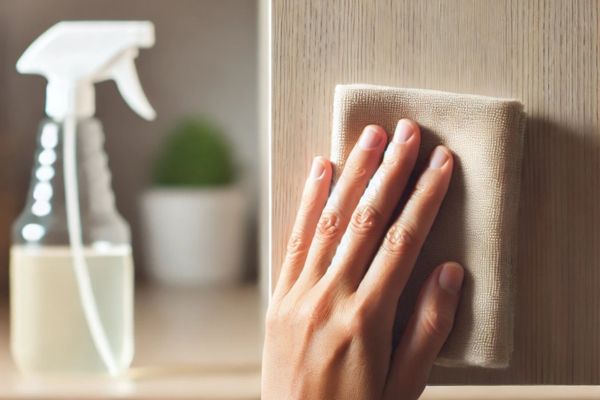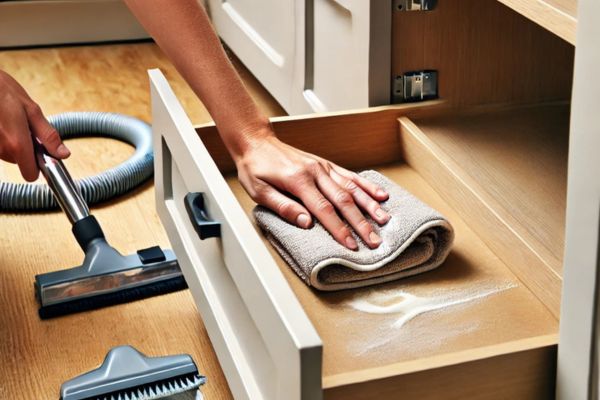Bathroom cabinets play a crucial role in maintaining the aesthetics and functionality of your space. Over time, they can accumulate dust, grime, and moisture-related stains, making regular cleaning essential. Clean bathroom cabinets not only enhance the overall hygiene of your bathroom but also prolong the life of the cabinetry. In this guide, we’ll walk you through a detailed process to restore the sparkle to your cabinets, whether they’re wood, laminate, or painted.
Importance Of Clean Bathroom Cabinets
Clean bathroom cabinets contribute to a healthier living environment. They prevent the buildup of mold and bacteria, especially in a humid area like the bathroom. Regular maintenance also ensures that your cabinets remain visually appealing and functional. Moreover, it protects your investment, keeping your cabinetry in top-notch condition for years to come.
Overview Of The Cleaning Process
Cleaning bathroom cabinets involves a systematic approach to address both the exterior and interior surfaces. The process includes gathering the right tools, preparing the cabinets, and using appropriate cleaning solutions tailored to the material of the cabinetry. A thorough cleaning routine not only removes surface dirt but also tackles hidden grime and bacteria.
Tools And Supplies You’ll Need
- Soft microfiber cloths
- Mild detergent or dish soap
- Vinegar and baking soda (optional)
- Warm water
- Sponge or scrub brush
- Toothbrush for detailing
- Vacuum with hose attachment
- Non-abrasive cleaning solution
- Wood polish or furniture wax (for wood cabinets)
- Rubber gloves
Having the right tools at hand ensures efficiency and minimizes the risk of damaging your cabinets.
Preparing Your Bathroom Cabinets For Cleaning
Before diving into cleaning, remove all items from the cabinets. This step allows you to access every nook and cranny. Use a vacuum or a dry cloth to eliminate dust and debris. Inspect the cabinets for any damage, such as peeling paint or loose hinges, and address these issues before proceeding with the cleaning process.
Step-By-Step Guide To Cleaning Bathroom Cabinets
Step 1: Cleaning Wood Cabinets

Wood cabinets require gentle care to avoid damaging their finish. Use a mixture of warm water and mild detergent. Dampen a microfiber cloth and wipe the surface, following the grain of the wood. For stubborn spots, use a soft toothbrush. Dry the cabinet immediately to prevent water stains, and finish with wood polish for a lustrous shine.
Step 2: Cleaning Laminate Or Painted Cabinets

Laminate and painted cabinets are more resistant to water but still need careful handling. Use a non-abrasive cleaner or a vinegar solution to wipe down surfaces. Avoid soaking the cabinet, as excessive moisture can seep into edges and cause swelling or peeling.
Step 3: Cleaning Inside The Cabinets

The interior of the cabinet often harbors hidden grime. Use a vacuum with a hose attachment to remove loose debris, then wipe down surfaces with a damp cloth. For sticky residue, apply a baking soda paste and let it sit for a few minutes before scrubbing gently.
Step 4: Cleaning Cabinet Hardware

Cabinet handles, knobs, and hinges are hotspots for dirt and bacteria. Remove detachable hardware and soak them in a mixture of warm water and dish soap. Scrub with a toothbrush, rinse, and dry thoroughly before reattaching.
Natural Cleaning Solutions For Eco-Friendly Results

For an environmentally friendly approach, consider using natural cleaners like vinegar, baking soda, or lemon juice. These ingredients effectively cut through grease and grime without introducing harsh chemicals into your home. For example, a 1:1 vinegar-water solution works wonders on most cabinet surfaces, leaving them spotless and fresh.
Preventing Future Dirt And Grime
Prevention is key to reducing cleaning efforts in the future. Use these tips to keep your cabinet in pristine condition:
- Wipe spills immediately to prevent stains.
- Use liners to protect the interior surfaces.
- Clean handles regularly to minimize grime buildup.
- Ensure proper ventilation in your bathroom to reduce humidity levels.
Deep Cleaning And Seasonal Maintenance
While regular cleaning keeps cabinet tidy, a deep clean is necessary every few months. This includes removing all contents, scrubbing interiors thoroughly, and polishing exteriors. Seasonal maintenance also involves inspecting for wear and tear, ensuring your cabinet remain functional and visually appealing.
Common Mistakes To Avoid
- Using harsh chemicals: These can damage finishes and weaken materials.
- Soaking cabinets: Excessive moisture can lead to warping or swelling.
- Neglecting the hardware: Dirty handles can harbor bacteria.
- Skipping drying: Always dry surfaces to avoid water damage.
Benefits Of Keeping Bathroom Cabinets Clean
The benefits extend beyond aesthetics. Clean cabinets improve air quality by reducing allergens and mold. They also enhance the durability of your cabinetry, saving you money on repairs or replacements. A clean bathroom creates a more inviting and pleasant space for you and your guests.
Faqs
How Often Should I Clean My Bathroom Cabinets?
It’s recommended to clean the bathroom cabinet every 2-4 weeks for routine maintenance. This prevents dust, grime, and mold from building up. For a more thorough clean, including the interiors and hardware, deep cleaning every 3-6 months is ideal.
Can I Use Bleach On My Cabinets?
Bleach is generally not recommended for Organize bathroom cabinet, especially wood or painted surfaces, as it can strip finishes, discolor surfaces, and weaken materials. For heavy-duty cleaning, opt for a mild detergent or a vinegar solution that’s safer and equally effective.
What’s The Best Way To Clean Sticky Cabinet Surfaces?
Sticky residue can be tackled using a paste made of baking soda and water. Apply it to the sticky areas, let it sit for a few minutes, then scrub gently with a soft sponge or cloth. For a natural alternative, a vinegar-water solution also works wonders.
How Do I Maintain The Finish On The Wood Cabinet?
To maintain the finish on the wood cabinet, clean gently with a damp cloth followed by immediate drying to prevent water damage. Use a high-quality wood polish or furniture wax periodically to enhance the shine and protect the surface from wear and tear.
Is It Necessary To Clean The Back Of The Cabinets?
Yes, cleaning the back of the cabinet is necessary, as dust and moisture can accumulate over time. While it doesn’t require frequent attention, include it during seasonal deep cleaning to ensure comprehensive maintenance.
Conclusion
Maintaining clean bathroom cabinets is a rewarding endeavor that elevates both hygiene and aesthetics. By following the outlined steps, using the right tools, and adopting preventive measures, you can keep your cabinet looking immaculate and functional. Commit to regular upkeep, and your bathroom will remain a sanctuary of cleanliness and comfort.


